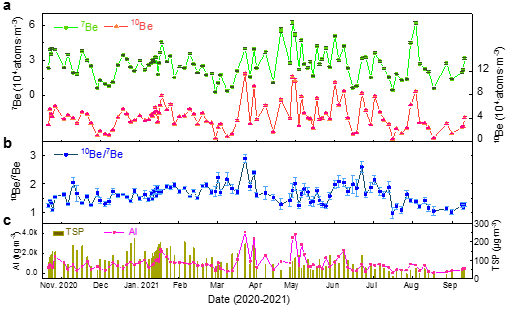Revealing Stratospheric Air Intrusion Process Based on Cosmogenic Beryllium
Long-term monitoring of radionuclides transported with through the atmosphere has significant implications for revealing atmospheric dynamics. The cosmogenic 10Be/7Be ratio is an effective tracer of atmospheric motion. However, the high-resolution data acquisition is limited because the 7Be-γ spectral counting method requires large samples size, and 10Be can only be measured by accelerator mass spectrometry (AMS). Public reports of complete high-precision 10Be/7Be records are currently scarce, especially in China.
Recently, a research group from the Institute of Earth Environment of the Chinese Academy of Sciences (IEECAS) obtained the Atmospheric 7Be and 10Be observational records with daily resolution for the whole year in Chengdu by the 7Be-10Be-AMS analysis method.
Based on this observation record, by effectively removing the interference of approximately 22% of the annual average resuspended dust 10Be, the long-period continuous tracer of the stratospheric air intrusion in the Sichuan Basin has been preliminarily realized, and it is found that the intensity of stratospheric air intrusion in spring and summer is significantly higher than in autumn and winter by approximately 4 times. This work also clarifies the effect of stratospheric air intrusion on surface O3 and water vapor in the Sichuan Basin.
The local synoptic-scale stratospheric air intrusion can cause rapid downward transmission of natural and anthropogenic trace chemicals in the stratosphere. The accumulated first-hand observational data obtained here were used to evaluate the migration of atmospheric substances and their impact on the environment and climate during the stratospheric atmospheric air intrusion in the Sichuan Basin. This is one of the four major basins in China, it is densely populated, and changes in the atmospheric environment there can have important impacts on human health.
This work also demonstrated that high-resolution 10Be/7Be can be used as an effective tracer for deep convective transport in the stratospheric atmosphere. And it provides a new research method for exploring the upper atmosphere source of surface atmospheric ozone.
The research work published in the Journal of Geophysical Research: Atmospheres, was jointly funded by the the Strategic Priority Research Program of Chinese Academy of Sciences (B), the National Natural Science Foundation of China, and Youth Innovation Promotion Association CAS. .

Fig. 1 Time series of atmospheric 10Be/7Be ratio (a), surface O3 and temperature (b) and RH (c) in Chengdu on the weekly time scale. Note: Observations are sorted by season. (Image by LIU, et al)

Fig. 2 Observation records at daily resolution of aerosol 7Be and 10Be concentrations (a), 10Be/7Be ratio (b), total suspended particulate matter (TSP) and aerosol Al content (c) in Chengdu area. (Image by LIU, et al)
Contact: Bai Jie, Institute of Earth Environment, Chinese Academy of Sciences, Xi'an, China. Email: baijie@ieecas.cn
 © 2015 Institute of Earth Environment,CAS
© 2015 Institute of Earth Environment,CAS Address:No. 97 Yanxiang Road, Xi'an 710061, Shaanxi, China

 Location :
Location :